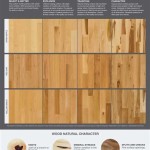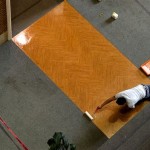How To Fix Tongue and Groove Laminate Flooring
Laminate flooring, known for its durability and aesthetic appeal, often utilizes a tongue and groove system for installation. This system allows planks to interlock, creating a stable and visually seamless surface. However, despite its robustness, laminate flooring is susceptible to damage or wear over time. Addressing issues promptly is crucial to maintain the floor's integrity and appearance. This article provides comprehensive guidance on how to repair various problems commonly encountered with tongue and groove laminate flooring.
Before commencing any repair work, it is essential to accurately identify the problem. Common issues include chipped or damaged planks, separation between planks, swelling due to moisture, and squeaking or creaking noises. A thorough assessment will inform the appropriate repair strategy and ensure that the correct tools and materials are selected. Safety precautions should always be observed. Wear appropriate protective gear, such as safety glasses and gloves, and ensure the work area is well-ventilated.
Replacing Damaged Planks
One of the most common repairs involves replacing individual planks that have been chipped, scratched, or otherwise damaged. This process requires careful execution to maintain the floor's overall appearance and structural integrity.
The first step is to acquire a replacement plank that matches the existing flooring in terms of color, pattern, and thickness. It is advisable to retain extra planks from the initial installation for this purpose. If replacement planks are unavailable from the original source, a close match should be sourced from a flooring retailer. Prior to installation, carefully examine the replacement plank for any defects.
Removing the damaged plank can be achieved through several methods, depending on its location within the floor. If the damaged plank is located near the edge of the room, it can be carefully pried up using a pry bar and shims. The shims protect the surrounding planks from damage. If the damaged plank is located in the middle of the floor, a more involved procedure is necessary.
For planks in the middle of the floor, use a circular saw or oscillating multi-tool to carefully cut out the damaged section. Set the saw to the depth of the laminate to avoid damaging the subfloor. Make several plunge cuts to create a manageable section to remove. Use a chisel and hammer to carefully detach the remaining pieces of the damaged plank from the surrounding planks, taking care not to damage the tongue and groove connections.
Once the damaged plank has been removed, prepare the area for the new plank. Clean any debris or adhesive residue from the subfloor. Carefully inspect the surrounding planks to ensure the tongue and groove connections are intact and undamaged. If any damage is present, use a wood chisel to carefully repair the connections.
Installing the new plank requires careful alignment and attachment. Apply a small amount of construction adhesive to the subfloor to secure the new plank. Align the tongue and groove of the new plank with the surrounding planks. Use a tapping block and hammer to gently tap the new plank into place, ensuring a tight and seamless fit. Wipe away any excess adhesive immediately. Place weights on the repaired area for the recommended curing time as per the adhesive manufacturer's instructions.
For planks that were removed by cutting, a technique known as "floating" the new plank is often employed. This involves applying construction adhesive to the edges of the new plank where it will meet the surrounding planks. Carefully position the new plank into the opening, ensuring a snug fit. Use painter's tape to secure the edges of the new plank to the surrounding planks while the adhesive cures. This prevents movement and ensures a strong bond. Remove the tape once the adhesive has fully cured.
Addressing Gaps Between Planks
Gaps between laminate flooring planks can occur due to various factors, including changes in humidity, improper installation, or subfloor movement. These gaps can detract from the floor's appearance and create areas where dirt and debris can accumulate. Addressing these gaps promptly is essential to prevent further damage and maintain the floor's integrity.
Before attempting to close the gaps, it is important to identify the cause. If the gaps are seasonal and appear during the drier months, they may be due to the natural expansion and contraction of the laminate. In this case, adjusting the baseboards or trim to allow for expansion may be sufficient. If the gaps are persistent or widespread, a more thorough repair may be necessary.
For small gaps (less than 1/8 inch), a color-matched wood filler or laminate repair putty can be used. Clean the area around the gap thoroughly to remove any dirt or debris. Apply the filler or putty to the gap, using a putty knife to smooth it out and blend it with the surrounding flooring. Allow the filler or putty to dry completely according to the manufacturer's instructions. Lightly sand the repaired area with fine-grit sandpaper to remove any excess filler and create a smooth surface. Apply a sealant to protect the repaired area and prevent future damage.
For larger gaps, a more substantial approach may be required. In some cases, it may be possible to gently tap the planks back together using a tapping block and hammer. Place a tapping block against the edge of the plank and gently tap it towards the adjacent plank. Use caution not to damage the tongue and groove connections. If the planks are difficult to move, it may be necessary to use a pull bar to exert more force. A pull bar is a specialized tool designed to pull planks together without damaging them.
If the planks cannot be moved back together, it may be necessary to remove and reinstall them. This process involves carefully disassembling the flooring section, starting from the edge of the room. Use a pry bar and shims to gently lift the planks, taking care not to damage the tongue and groove connections. Once the planks have been removed, inspect the subfloor for any unevenness or damage. Repair any subfloor issues before reinstalling the planks.
When reinstalling the planks, ensure they are properly aligned and interlocked. Use a tapping block and hammer to gently tap the planks into place, ensuring a tight and seamless fit. If necessary, apply construction adhesive to the tongue and groove connections to provide additional stability. Reinstall the baseboards or trim, leaving a small gap (approximately 1/4 inch) to allow for expansion and contraction.
Quieting Squeaky Floors
Squeaking or creaking laminate flooring can be a common nuisance. These noises are typically caused by friction between the planks, the subfloor, or the underlayment. Identifying the source of the squeak is the first step in resolving the problem.
Walk across the floor and listen carefully to pinpoint the location of the squeaks. Mark the areas where the noises are most prominent. Once the location has been identified, investigate the underlying causes. Common causes of squeaking include loose planks, uneven subfloor, and inadequate underlayment.
For localized squeaks, injecting a lubricant into the seams between the planks can often provide a temporary solution. Use a specialized laminate floor lubricant or a powdered graphite product. Apply the lubricant sparingly, using a syringe or applicator to target the squeaky area. Wipe away any excess lubricant immediately. This method works best for minor squeaks caused by slight friction between planks.
If the squeaking is due to loose planks, it may be necessary to secure them to the subfloor. This can be achieved by using construction adhesive or by driving screws through the planks into the subfloor. Before using screws, locate the floor joists beneath the subfloor to ensure secure anchoring. Pre-drill pilot holes to prevent splitting the planks. Countersink the screws so that they are flush with the surface of the floor. Fill the screw holes with color-matched wood filler or laminate repair putty.
In some cases, squeaking can be caused by an uneven subfloor. The unevenness creates gaps between the laminate flooring and the subfloor, leading to friction and noise. Addressing this issue requires more extensive work. The laminate flooring must be removed in the affected area to access the subfloor. Inspect the subfloor for any unevenness or damage. Use a leveling compound to smooth out any uneven areas. Allow the leveling compound to dry completely according to the manufacturer's instructions. Reinstall the laminate flooring, ensuring it is properly aligned and interlocked. This method provides a more permanent solution by addressing the underlying cause of the squeaking.
Another potential cause of squeaking is inadequate or deteriorated underlayment. The underlayment provides a cushion between the laminate flooring and the subfloor, reducing friction and noise. If the underlayment is compressed or damaged, it may no longer provide adequate support. Replacing the underlayment requires removing the laminate flooring in the affected area. Inspect the existing underlayment for any signs of wear or damage. Replace the underlayment with a new, high-quality underlayment that is specifically designed for laminate flooring. Reinstall the laminate flooring, ensuring it is properly aligned and interlocked.
Addressing tongue and groove laminate flooring issues requires a methodical approach, careful attention to detail, and the use of appropriate tools and materials. By accurately diagnosing the problem and following the steps outlined above, homeowners can effectively repair their laminate flooring and maintain its beauty and longevity.

Tongue Or Groove Which To Install First

All You Need To Know About Tongue And Groove Flooring Installation Reallyfloors America S Est Hardwood

What Is The Tongue And Groove On Laminate Flooring

Pergo Installation Laminate Flooring Sawdust Girl

Standard Tongue And Groove Flooring Installation

Installing Laminate Engineered Wood Floating Floors Home Improvement Stack Exchange Blog

5 Essential Tips For Tongue And Groove Flooring District Floor Depot

How To Install Laminate Flooring The Home Depot

How To Replace A Damaged Laminate Board That S In The Middle Of Floor

How To Install Beautiful Laminate Floors In One Afternoon Do It Yourself Fun Ideas
Related Posts








